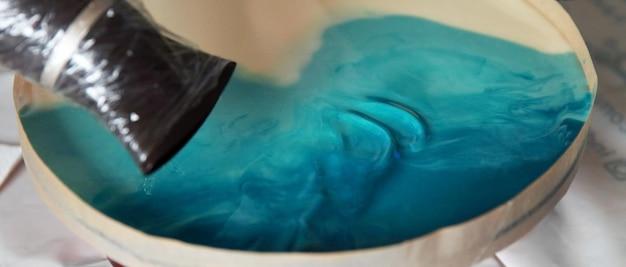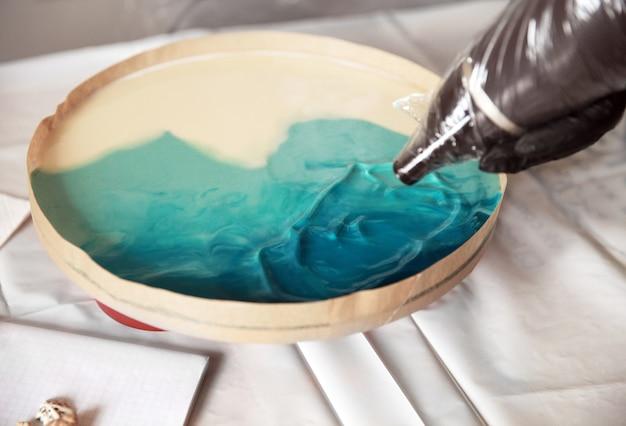Resin is a popular material used in various crafts and DIY projects due to its versatility and durability. However, accidents can happen, and you might find yourself with resin on your skin. So, what exactly happens when you get resin on your skin? In this blog post, we’ll explore the effects of resin on the skin and provide you with some helpful tips on how to remove it safely.
If you’ve ever wondered about the potential dangers of resin, whether it’s toxic while curing, or if resin fumes can make you sick, we’ll address all your concerns. We’ll also tackle how to clean up after using epoxy resin and offer advice on the appropriate safety measures to take, such as wearing a mask. Additionally, we’ll discuss the implications of getting resin on your skin and how to deal with it promptly and effectively.
So, if you’re ready to learn about the dangers and remedies associated with resin on your skin, read on to find out what you should do if this situation occurs.
What Happens If Resin Finds Its Way Onto Your Skin
We’ve all been there – in the middle of a crafting project, totally absorbed in the world of resin, when all of a sudden, disaster strikes. A dollop of sticky, gooey resin lands right on your skin, as if it’s claiming you as its new canvas. Panic sets in, and you start wondering what on earth will happen next.
Resin: The Not-So Gentle Embrace
Resin may seem harmless, but it can be quite clingy when it comes to your skin. Its sticky nature ensures that it holds on for dear life, refusing to let go easily. Once it lands on your skin, it stays put until you make a move to remove it.
The Race Against the Clock
Time becomes your biggest adversary when resin decides to take up residence on your skin. As it hardens, it forms a solid bond, making it increasingly difficult to remove. So, while you may feel tempted to take a break and admire your new accessory, it’s best to act swiftly before your skin becomes a permanent artsy exhibit.
Hello, Skin Irritation!
Resin is not particularly skin-friendly. In fact, it can cause quite a bit of irritation. You might experience redness, itching, or even a burning sensation in the affected area. It’s your body’s way of letting you know that it’s not thrilled about having resin as an unexpected visitor.
Demolishing Resin Residue
Fear not! There’s hope for removing that pesky resin from your skin. Begin by washing the area with warm, soapy water, gently scrubbing in circular motions. If the resin is being a bit too stubborn, try using a gentle exfoliating scrub or a mixture of baking soda and water to help break down the bond. In no time, your skin will be free from the clutches of resin.
The Moisture Mystery
As you bid farewell to the sticky intruder, you might notice that your skin feels a bit dry. This is because resin has a tendency to strip the skin of its natural oils, leaving it parched and in need of some extra love and care. A moisturizer will be your skin’s new best friend, restoring hydration and nourishment.
Prevention Is Key
They say prevention is better than cure, and it couldn’t be truer in the case of resin and your skin. To avoid any resin-related mishaps, consider wearing gloves while working with resin. Not only will this protect your skin, but it will also prevent resin from seeping into your nails and wreaking havoc.
The Sweet Release
Finally, the resin has been defeated, and your skin can breathe a sigh of relief. It’s time to continue with your crafting project or simply marvel at your newfound knowledge of resin and skin interactions. Just remember, if resin decides to pay you another visit in the future, you now have the knowledge and tools to bid it a quick farewell.
So there you have it! The saga of resin on skin comes to an end, but the lessons learned will stick with you like, well, resin on your fingers. Stay cautious, keep those gloves handy, and may your crafting adventures be resin-free!
FAQ: What Happens If You Get Resin On Your Skin
Introduction
So, you’ve found yourself in a sticky situation (literally) and managed to get resin on your skin. Don’t worry, it happens to the best of us! But what should you do next? In this FAQ-style guide, we’ll answer all your burning questions about what happens when resin meets your skin and how to handle it like a pro.
How do I remove resin from my floor
Accidents happen, and resin might have found its way onto your beloved floor. Fear not! To remove resin from your floor, follow these steps:
- Start by scraping off as much resin as possible with a plastic scraper or a credit card. Be gentle to avoid damaging the floor.
- Once the excess is removed, mix a solution of warm water and mild dish soap.
- Soak a soft cloth or sponge in the soapy water and gently scrub the affected area.
- Rinse with clean water and pat dry.
Are resin fumes harmful
Resin fumes can be quite pungent and overpowering, but the good news is that they are generally not harmful in small doses. However, it’s always recommended to work in a well-ventilated area or use a respiratory mask for added protection.
How long does the toxicity of epoxy last
Epoxy can be toxic during the curing process, but the toxicity diminishes as it cures completely. Typically, epoxy is fully cured within 24-72 hours, depending on the specific product used.
Can epoxy be cancerous
No, epoxy resin itself is not considered cancerous. However, some epoxy products may contain additives or chemicals that could potentially pose health risks. It’s important to check the safety information provided by the manufacturer and use the product according to their guidelines.
Should I wear a mask while working with resin
Absolutely! While resin itself may not be extremely toxic, the fumes can be irritating and potentially harmful when inhaled in large amounts. Protect your respiratory system by wearing a mask specifically designed for chemical fumes.
Can resin harm your lungs in the long run
Prolonged exposure to resin fumes without proper ventilation or protection can indeed pose risks to your lungs. It’s crucial to prioritize safety and take necessary precautions, such as wearing a mask and working in a well-ventilated space.
Is resin toxic while it’s curing
Yes, resin can release toxic fumes during the curing process. That’s why it’s important to set up your work area in a well-ventilated space or consider using a dedicated respirator mask for added protection.
What should I do if I get epoxy resin on my skin
If you accidentally get epoxy resin on your skin, don’t panic! Follow these steps to remove it without any hassle:
- Immediately wash the affected area with soap and warm water.
- Gently scrub the resin with a soft cloth or sponge until it starts to loosen.
- Rinse the area thoroughly with water.
- Apply a soothing lotion or cream to moisturize the skin and promote healing.
Can resin cause burns on the skin
While resin itself may not cause burns, it can generate heat as it cures. If you notice any discomfort or burning sensation while resin is on your skin, remove it immediately and rinse the area with cool water.
What happens if I inhale too much resin
Inhaling excessive resin fumes can cause irritation to the respiratory system and may lead to symptoms such as coughing, wheezing, or shortness of breath. If you experience these symptoms, it’s essential to move to a well-ventilated area and seek fresh air.
Can resin fumes make me sick
Yes, inhaling resin fumes in large quantities can make you feel sick. Symptoms may include headaches, nausea, dizziness, or even allergic reactions for some individuals. To avoid these uncomfortable side effects, always work in a well-ventilated space and wear proper respiratory protection.
Is resin toxic to the skin
Epoxy resin itself is generally not toxic to the skin. However, some people may experience skin irritation or an allergic reaction when exposed to resin. If you notice any redness, itching, or discomfort, wash the area thoroughly and seek medical advice if the symptoms persist.
What are the dangers associated with resin
While resin can be a fabulous medium for creativity, it’s important to be aware of potential dangers. These include skin irritation, respiratory irritation from fumes, and risks associated with improper handling or ingestion. By following safety guidelines and using resin responsibly, you can minimize any potential risks.
How long do resin fumes linger
Resin fumes can linger in the air for several hours or even days, depending on factors such as ventilation and curing time. To ensure a safe environment, make sure to provide proper ventilation in your workspace and avoid unnecessary exposure.
Can vinegar remove epoxy
Vinegar can be used as a handy DIY solution to remove epoxy residue from surfaces. Soak a cloth or sponge with vinegar and gently rub the affected area. However, keep in mind that vinegar may not be suitable for all surfaces, so it’s advisable to test it on a small, inconspicuous area first.
What is the safest resin to use
When it comes to safety, it’s essential to choose a resin that is labeled as non-toxic or food-safe. These resins are formulated to have fewer potentially harmful additives, making them safer to use for both artistic and practical purposes. Always check the product specifications and safety information provided by the manufacturer to ensure the utmost safety.
Conclusion
Now that you’re all clued up on what happens if resin gets on your skin, you can handle any sticky situation like a pro! Remember, safety should always be a priority, so take adequate precautions, work in a well-ventilated area, wear protective gear, and follow manufacturer guidelines. Stay safe, create marvelous resin masterpieces, and enjoy the creative journey!

